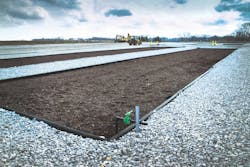Limiting the Lagoon
Small communities across the U.S. are faced with meeting low discharge ammonia levels required by new National Pollutant Discharge Elimination System permit limits. Current effluent Total Ammonia–N (TAN, or total ammonia measured in terms of nitrogen content)water quality standards in Iowa are in the range of 1 mg/L (summer) and 5 to 10 mg/L (winter). To many small municipalities, options for post-lagoon nutrient removal are restricted by limited budgets.
Located in Linn County, Iowa, the city of Walker’s wastewater treatment facility consisted of a two-cell, non-aerated, controlled discharge lagoon. The lagoon system was permitted to discharge every 180 days during the spring and fall. The plant had reached maximum hydraulic capacity, however, and was required to discharge more frequently than allowed by its permit due to lack of available storage.
To protect the receiving stream, the city considered different upgrade options. HR Green Consultants was hired to complete a new facility plan for Walker’s wastewater treatment facility. Factors considered during the planning process included capital cost, operation and maintenance cost, energy consumption, operator certification, and ability to meet low ammonia limits, even during extended periods of low winter water temperatures. A variety of options were reviewed, including expansion of the existing lagoon system or building a new mechanical treatment plant. A continuous-discharge aerated lagoon system was selected, which required that the effluent quality meet ammonia toxicity requirements year round.
Conventional aerated lagoon systems provide some ammonia removal in warmer months but generally are incapable of meeting ammonia limits during periods of low water temperatures (less than 40°F). The consultant selected the Submerged Attached Growth Reactor (SAGR) process to provide post-lagoon ammonia removal and effluent polishing, enabling Walker to retain and reuse its existing lagoon infrastructure.
SAGR Process
The SAGR upgrade was designed in accordance with the Iowa Wastewater Facilities Design Standards and received Department of Natural Resources (DNR) approval in 2012. The SAGR is a patented process developed by Nelson Environmental.
The system consists of an aerated gravel bed with a horizontal flow distribution chamber at the front end to distribute influent wastewater across the width of the entire cell. The aggregate is submerged, providing the necessary surface area for growth and attachment of nitrifying biomass within the bed, and is sized to optimize bacterial growth and hydraulic flow. A horizontal collection chamber at the end of the treatment zone collects the process effluent.
The SAGR system was specifically designed for cold temperature nitrification following lagoon systems, which may experience winter water temperatures as low as 32.9°F for up to five months. Sizing of the bed is based on ammonia loading rates to provide year-round nitrification that easily meets ammonia discharge permit requirements.
An added benefit of the process is effluent polishing to biological oxygen demand (BOD) and total suspended solids (TSS) levels of less than 10 mg/L. Data from other SAGR facilities also have shown 99%-plus reduction of fecal coliform bacteria, providing redundancy when paired with ultraviolet (UV) disinfection.
Ease of operation was a primary consideration during development of the SAGR. There are no sludge or solids management requirements, making the process O&M similar to that of a conventional aerated lagoon. The only moving parts in the system are blowers supplying oxygen to the process. Process control requirements are limited to seasonal (twice a year) manipulation of the influent control valves.
Facility Upgrade
In April 2012, construction began on the facility upgrade. The existing eastern facultative cell was by-passed, and a three-cell aerated lagoon system was constructed within the footprint of the existing western facultative cell. A fine bubble diffused aeration system was supplied for the two partial mix cells to achieve improved year-round BOD and TSS removal. Cell 3 is utilized for non-aerated settling, as required by Iowa DNR standards. Four SAGR beds were constructed following the lagoon cells, and a UV disinfection system was provided for disinfection prior to discharge.
Nelson Environmental staff provided commissioning and operational training on Oct. 10, 2012. Results through the first winter of operation consistently met the new ammonia limits (see Figure 1).
This performance is expected to continue and improve as the SAGR process matures to establish an optimal biomass film within the beds.
The design approach for the Walker wastewater treatment facility demonstrates the ability to resolve hydraulic capacity issues and provide nitrification while maximizing the use of existing lagoon infrastructure. Capital costs were lower than construction of a mechanical treatment plant of equivalent treatment would have been, and the system maintains simplicity of operation, with low ongoing O&M requirements.
Download: Here
